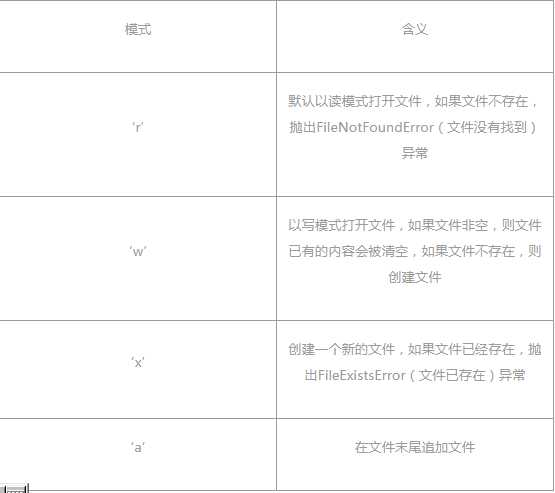标签:文档 aaaaaa 当前目录 安装 获取 nes loaded beautiful class
准备工作
1、安装Ipython(请见”Ipython的安装”)
2、实验用的文档(你自己用vi编辑器创建文件就好了)
一、Python内置的Open函数
在Python中,要对应文件进行操作,只要使用内置的Open函数打开文件即可。Open函数接受文件名和打开模式作为参数,返回一个文件对象。工程师通过文件对象来操作文件,完成以后,调用文件对象的close方法关闭文件即可。
例如,在当前目录下有一个名为data的文件,它的内容如下:
[root@master ~]# cat data Beautiful is better than ugly. Explicit is better than implicit. Simple is better than complex. Complex is better than complicated.
接下来,使用Open函数打开文件,调用文件对象的read方法读取文件的所有内容,完成以后,调用文件对象的close方法关闭文件,如下所示:
In [3]: f = open(‘data‘) In [4]: print(f.read()) Beautiful is better than ugly. Explicit is better than implicit. Simple is better than complex. Complex is better than complicated. In [5]: f.close()
与其他编程语言类似,open函数默认以’r’模式打开,也可以指定文件的打开模式,如表所示。
表 文件的打开模式

下面代码分别演示,打开一个不存在的文件时’w’模式与’x’模式的区别:
In [7]: f = open(‘data1.txt‘,‘w‘) In [8]: f.write(‘Hello World‘) Out[8]: 11 In [9]: f.close() In [10]: f = open(‘data1.txt‘,‘x‘) --------------------------------------------------------------------------- FileExistsError Traceback (most recent call last) <ipython-input-10-fc8069bb2b02> in <module> ----> 1 f = open(‘data1.txt‘,‘x‘) FileExistsError: [Errno 17] File exists: ‘data1.txt‘ In [11]: In [11]:
In [11]: f = open(‘data2.txt‘,‘x‘) In [12]: f.write(‘Hello World‘) Out[12]: 11 In [13]: In [13]: f.close() In [14]:
二、避免文件句柄泄露
在计算机程序中,每打开一个文件就需要占用一个文件句柄,而一个进程拥有文件的句柄是有限的。此外,文件句柄也会占用操作系统的资源,因此,在编写程序处理文件时需要注意,文件处理结束后及时关闭文件。文件句柄泄露或许是最常见的资源泄露问题,用finally关闭文件句柄。在Python中,也可以使用finally语句来保证,无论在什么情况下文件都会被关闭,如下所示:
try: f = open(‘data.txt’) print(f.read()) finally: f.close()
Python中还有更加简洁优美的写法,即使用上下文管理器。虽然使用finally语句能够保证资源一定关闭,但是没有上下文管理器简洁好用。如果工程师可以在上下文管理器的情况下,使用了Finally语句,将会认为代码写的不够Pythonic。对于文件打开、处理、再关闭的逻辑,使用上下文管理器代码如下:
| with open(‘data.txt’) as f: print(f.read()) |
可以看到,使用上下文管理器以后代码行数变少了。在Python中,如果想想把代码写的简洁优美,就应该在保证可读性的前提下代码行数越少越好。
三、常见的文件操作函数
Python的文件对象有多重类型的函数,如刷新缓存的flush函数,获取文件位置的tell函数,改变文件读取偏移量的seek函数。但是,工作中使用最多的还是与读写相关的函数。下面来看几个Python中的读写函数。
Python提供了三个读相关的函数,分别是read、readline和readlines,他们的作用如下:
我们可以使用上边的”data.txt”文件,分别测试这三个读函数的效果:
| In [1]: f = open(‘data.txt’) In [2]: f.read() Out[2]: ‘Beautiful is better than ugly.\nExplicit is better than implicit.\nSimple is better than complex.\nComplex is better than complicated.\n’ In [3]: f.seek(0)
Out[3]: 0 In [4]: f.readline() Out[4]: ‘Beautiful is better than ugly.\n’ In [5]: f.seek(0) Out[5]: 0 In [6]: f.readlines() Out[6]: [‘Beautiful is better than ugly.\n’, ‘Explicit is better than implicit.\n’, ‘Simple is better than complex.\n’, ‘Complex is better than complicated.\n’] |

这里可以看到,read和readlines函数都是一次就将所有内容读入内存中,对于文件较小的情况不会有什么问题。但是,如果处理的是大文件,这种使用方法会占用大量的内存,甚至有可能因为内存占用太多出现Out-Of-Memory错误。
Python提供了两个写函数,分别是write和writelines,他们的区别如下:
依然使用Ipython对文件对象的写入函数进行测试,并在写入完成以后使用Linux的cat命令查看文件内容:
| In [1]: f = open(‘data.txt’,’w’) In [2]: f.write(‘Beautiful is better than ugly.’) Out[2]: 30 In [3]: f.writelines([‘Explicit is better than implicit.’,’Simple is better than complex.’])
cat data.txt |


在Python中,除了使用文件对象的write函数和writelines函数向文件写入数据以外,也可以使用print函数将输出结果输出到文件中。print函数比write和writelines函数更加灵活,如下所示:
| From __fureture__ import print_function With open(‘data.txt’,’w’)as f: print(1,2,’hello world’,sep”,”.file=f) |
标签:文档 aaaaaa 当前目录 安装 获取 nes loaded beautiful class
原文地址:https://www.cnblogs.com/liujunjun/p/13475274.html